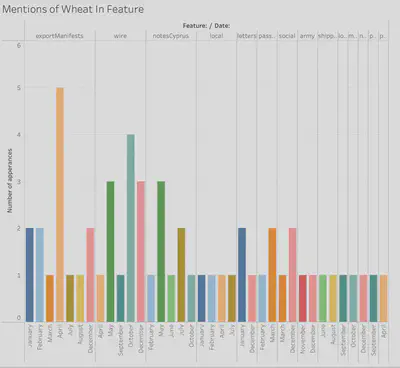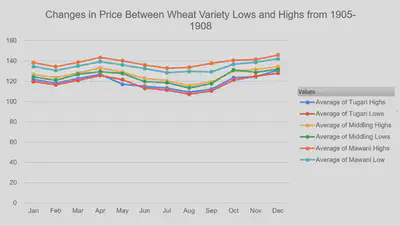Wheat Production and Importance in Egypt
Background
Our project analyzes the presence and importance of wheat in the eyes of the British in the Egyptian Gazette in the early 20th century. Egyptian wheat production was a massively important part of the day to day life of Egypt for millennia, from the days of the Pharaoh to the 19th century. Wheat was the main subsistence crop throughout the Nile Delta, and allowed the Egyptians to be wildly successful and allowed them autonomy even when they were conquered. Wheat’s staple status primarily came through its use in the production of both bread and beer. This was shown in the Roman conquest of Egypt, where they were granted autonomy from Rome until Cleopatra took Mark Antony’s side in the last war of the Roman Republic. The major importance of Egypt being the wheat basket of the Mediterranean allowed it and its ruling parties power and independence. This all came to an end under Muhammad Ali Pasha, who through large irrigation projects and the change to cotton based farming led Egypt to become a more economic power instead of sustainance based farming. This led to Egypt becoming less dependent on wheat and more dependent on the economic benefits of selling cotton and using the profit to buy food and develop the country overall.
Government influence
The government had a variety of programs to increase agriculture. One of the main crops they pushed was the production of wheat. One of the programs was the Cairo Agricultural show; this was an opportunity for the grower to show off their wheat production to potential buyers. It was a great networking event for many people. The Suez canal was a significant government transportation portal for the exporting of wheat. Great Britain exported most of Egypt’s wheat, leaving little for the people: “as little as 1/5 of the wheat was kept for the people” (Egyptian Gazette). The 1/5 portion was processed into other products such as bread. This policy of increasing economic revenue was done with a little more of a selfish nature rather than helping the individual farmer. However, to make up for this selfish nature, the government had to deal with the crime of people stealing each other’s crops and took these cases very seriously.
Over time, controversy began to grow about whether wheat or cotton was more profitable. The British saw wheat as mainly a single-dimensional product that was only for flour production. The big cash crop was cotton due to the greater demand during the US civil war and greater transferability. This is mentioned throughout the article “British flour for Egypt” in the Egyptian Gazette. Although the British thought this, they still did a lot to help increase the production of wheat; in the Egyptian Gazette, the feature “abridged prospectus” explained the process of purchasing the land and how the process was meant to incentivize people to buy and start cultivating the wheat crop. The most popular land was lower Egypt which had the rich soil to grow good wheat. The process of securing land could get a little complicated, but there was a program to help poorer people get their foot in the door. Through this program, you could buy a share of land and make payments. However, if you miss only one payment, your entire land could be revoked. These payments could be expensive, especially with the hefty tax you pay to auditors. This extreme policy really pressured farmers to produce most of the crops. This excessive production made local articles such as “Khartoum’s wheat crop” describe wheat as a very profitable crop since it was written from the local perspective.
In addition, the Egyptian Gazette has an article called “British Flour,” which was written in March 4, 1907. Throughout this text, the author talks about the shift from wheat production to more cotton production due to its further profitability. So, the government shifted focus and realized money was better than extra production. The article details how as wheat increased, the demand and sales remained the same, and the primary consumers were the British Mill, which had its own competition with the French miller for being a top supplier. Our second visual below about wheat prices displays how although foreign governments such as the British didn’t increase their wheat purchase during March of 1907, wheat remained at a steady price due to Egypt’s ability to distribute the extra grain elsewhere. This displays wheat’s ability to have stable and growing production and how it was an essential part of commerce, even though government support was shifting.
Research
We initially decided to find out how often wheat was mentioned in each feature within the Egyptian gazette. This piece of information would show how relevant this specific crop is and what times during the year that it is being discussed. The following query was used to find this information://div[matches(.,'wheat', 'i')]/@feature
This data showed us that there was not a specific time of the month or a season that wheat was discussed like we had assumed. It is relevant throughout the year. However it is mentioned the least during months June, August, and November. Wheat was mentioned in exportManifest more frequently compared to the other features. This search gave 56 items, which are listed below.
- 1884-02-18 exportManifests
- 1905-02-09 passList
- 1905-03-08 passList
- 1905-03-20 exportManifests
- 1905-04-11 exportManifests
- 1905-04-17 exportManifests
- 1905-04-24 exportManifests
- 1905-04-26 wire
- 1905-09-20 parisLetter
- 1905-09-23 londonLetter
- 1905-12-12 wire
- 1906-01-03 letters
- 1906-01-19 exportManifests
- 1906-02-23 exportManifests
- 1906-03-08 passList
- 1906-03-22 social
- 1906-06-01 notesCyprus
- 1906-12-03 wire
- 1907-01-10 local
- 1907-02-12 notesCyprus
- 1907-02-22 local
- 1907-04-02 exportManifests
- 1907-04-16 local
- 1907-04-18 prepaidAdvertisements
- 1907-05-03 notesCyprus
- 1907-05-15 wire
- 1907-05-21 notesCyprus
- 1907-05-22 wire
- 1907-05-24 wire
- 1907-05-27 notesCyprus
- 1907-06-24 shippingMovements
- 1907-07-10 exportManifests
- 1907-07-17 local
- 1907-07-24 notesCyprus
- 1907-08-19 shippingMovements
- 1907-08-30 exportManifests
- 1907-09-25 wire
- 1907-10-16 wire
- 1907-10-17 notesCyprus
- 1907-10-18 wire
- 1907-10-19 masthead
- 1907-10-21 wire
- 1907-10-24 wire
- 1907-11-13 army
- 1907-12-03 exportManifests
- 1907-12-05 letters
- 1907-12-06 social
- 1907-12-07 notesOther
- 1907-12-09 exportManifests
- 1907-12-12 wire
- 1907-12-13 army
- 1907-12-17 social
- 1908-01-03 letters
- 1908-01-31 exportManifests
Data Visualization


Conclusion
Based on our research, we accomplished our goal of finding out the significance of wheat during this time period. Together we have gathered a mixture of qualitative and quantitative research to develop a better picture of the impact of wheat cultivation. With this better picture, we were able to highlight the importance of this crop. Through our deep dive into the Egyptian Gazette, we also established that wheat was a main crop that was produced. Furthermore, we examined the effects that the native government and foreign influence had on the production and use of Wheat. The data showed how significant this crop was in the process of cultivating economic growth for Egypt, especially under British control. Detailed evidence, such ⅕ of the production of wheat, was given to the people in Egypt; the rest was exported to other countries, which led us to formulate more complex conclusions. The most apparent conclusion we were able to draw was that, over time, cotton became the main crop since there was more of a demand for it.
Works Consulted
Foaden. “Text-Book of Egyptian Agriculture, Ed. by G. P. Foaden … and F. Fletcher … v. 1.” HathiTrust, https://babel.hathitrust.org/cgi/pt?id=njp.32101048820458.
El-Sadek, A. Virtual Water Trade as a Solution for Water Scarcity in Egypt. Water Resource Manage 24, 2437–2448 (2010). https://doi.org/10.1007/s11269-009-9560-9